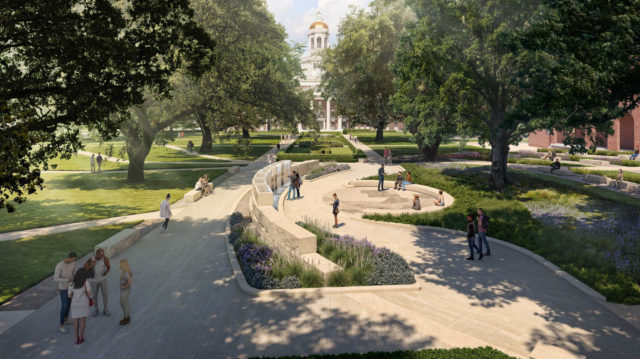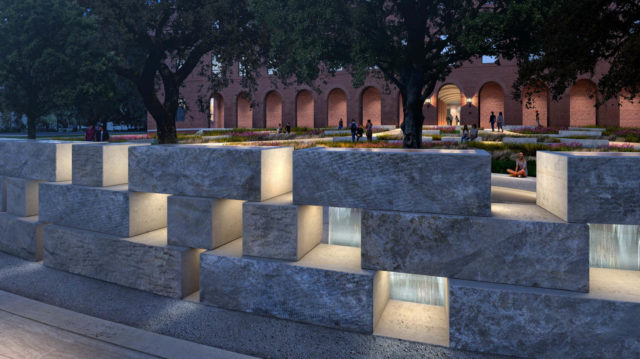
By Caitlyn Meisner | Copy Editor
Baylor’s Commission on Historic Campus Representations decided to create a Monument to the Unknown Enslaved to represent the history and use of slavery that was integral to building Baylor’s original campus in Independence.
The commission detailed in their December 2020 report that it’s necessary for the university to “publicly and visibly” recognize Baylor’s founders and original trustees as slaveowners to tell a more complete story.
This monument will be built in the space in front of Pat Neff Hall, also known as Founder’s Mall.
Reverend Dr. Malcolm Foley, special advisor to the president for equity and campus engagement, said its important to remember the enslaved labor and the injustices of slaves in the 19th century when Baylor was built.
“It’s an integral part of our founding and it’s important for us as a Christian university to be clear about that,” Foley said.
Foley also said it’s important for the Baylor community to engage in his “three r’s:” reckoning, repentance and reconciliation.
“We [must] reckon with the evil in our past, repent of it and turn towards the Lord, but also reconcile with one another,” Foley said. “We’re looking at a history of profound justice and we’re looking at opportunities to live more justly with one another and this is a physical representation of that commitment.”
Foley acts as the co-chair of campus experience for the commission along with Jason Cook, vice president of marketing and communications. Cook and Foley said they worked with the international architectural firm Sasaki to design the monument.
Cook and Foley also said they looked at a wide array of physical representations of the commission’s vision, and ultimately decided on a walkable monument rather than a statue. They said they already knew of the plans for the first Black graduates statues and wanted to do something different.
“As we were thinking about this memorial and thinking of questions, like ‘Hey, is there an individual that we want to recognize?'” Foley said. “As we look through this history, we have one enslaved person who we have record of. We know there were others, but don’t have data on them. [The design] is open-ended enough for us to be able to edit it as we learn more.”
Cook said the layout of the monument is intentional and deeply symbolic for the Baylor community.
“We kept coming back to themes of light and water because they are so central to the gospel and representative of the ‘three r’s’ Malcom talked about,” Cook said.
Cook said they are utilizing the existing sidewalks on Founder’s Mall and incorporating it into the monument’s design as well as incorporating one of Baylor’s most famous traditions, the Baylor Line.
“We’re curving the Baylor Line to to embrace this part of our history,” Cook said.

Cook said the monument will be constructed with limestone, which is the material that was used to build Baylor’s former campus in Independence. He also said the limestone has hand-chiseled demarcations, which shows the hard work and labor being put into the campus, likely by enslaved people.
Cook also said there will be gaps within the limestone blocks to demonstrate the gaps in Baylor’s history.
“What we’re saying is that we’re going to continue to learn more about Baylor’s past,” Cook said. “We’re going to keep working to try to fill the gaps in our university’s history, but also continue to seek who the unknown are as well.”

He said there are hopes to engrave names of the enslaved as they continue to be discovered.
Cook and Foley said they do not have a firm timeline established yet, but should in the fall of 2023. They said they want to move quickly with the monument, but are unsure of how long the project will take.
The space is meant to serve as a gathering place for the Baylor community to reflect on Baylor’s history and to represent the collaborative nature of the project, Cook and Foley said.
“This is to be a space for reflection, a gathering space [and] hopefully there will be new Baylor traditions that can revolve around this space,” Foley said. “This whole process was a deeply, deeply collaborative one, not only with us and the Board of Regents, but with a group of staff, faculty and students as well. We wanted to make sure that we brought the campus community together. “
Cook and Foley also said as the university strives toward more diversity and inclusion, Baylor must reconcile and recognize its history.
“If we’re to conceive of ourselves as a Baylor family, that means we have to be aware of not only the evils in our past, but of the tremendous opportunity that we have going forward,” Foley said. “It’s my hope that these physical representations will declare to folks that we want to be people invested in healing.
Foley said he hopes people recognize the continued commitment on Baylor’s behalf to continue improving and recognizing their history.
“None of these efforts are just one and done. This is part of just the continuing growth and development of our institution to become better and continue to live into the mission that we’ve historically tried to hold really tightly to,” Foley said.





